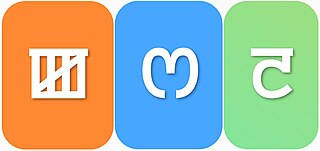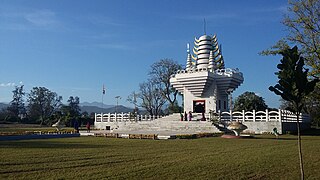
Languages spoken in the Republic of India belong to several language families, the major ones being the Indo-Aryan languages spoken by 78.05% of Indians and the Dravidian languages spoken by 19.64% of Indians; both families together are sometimes known as Indic languages. Languages spoken by the remaining 2.31% of the population belong to the Austroasiatic, Sino–Tibetan, Tai–Kadai, and a few other minor language families and isolates. According to the People's Linguistic Survey of India, India has the second highest number of languages (780), after Papua New Guinea (840). Ethnologue lists a lower number of 456.

Meitei also known as Manipuri, is a Tibeto-Burman language of northeast India. It is the official language and the lingua franca of Manipur and an additional official language in four districts of Assam. It is one of the constitutionally scheduled official languages of the Indian Republic. Meitei is the most widely-spoken Tibeto-Burman language of India and the third most widely spoken language of northeast India after Assamese and Bengali. There are 1.76 million Meitei native speakers in India according to the 2011 census, 1.52 million of whom are found in the state of Manipur, where they represent the majority of its population. There are smaller communities in neighbouring Indian states, such as Assam (168,000), Tripura (24,000), Nagaland (9,500), and elsewhere in the country (37,500). The language is also spoken by smaller groups in neighbouring Myanmar and Bangladesh.

Manipur University is a central university located in Imphal, Manipur, India. It was established on 5 June 1980, under the Manipur University Act, 1980, as a teaching cum-affiliating university with territorial jurisdiction over the state of Manipur. It was converted into a central university under the Manipur University Act, 2005 w.e.f. 13 October 2005.

The Meitei script, also known as the Kanglei script or the Kok Sam Lai script, after its first three letters is an abugida in the Brahmic scripts family used to write the Meitei language, the official language of Manipur, Assam and one of the 22 official languages of India. It is first known from engravings on 6th century CE coins and copper plate inscriptions. as verified by the various publications of the National Sahitya Akademi. It was used until the 18th century, when it was replaced by the Bengali alphabet. A few manuscripts survive. In the 20th century, the script was revived and is again being used. Beginning in 2021, the Government of Manipur began to use the Meitei alongside the Bengali-Assamese script, per the Manipur Official Language (Amendment) Act, 2021.

Tonthoingambi Leishangthem, popularly known as Tonthoi, is an Indian actress. She has established a career in Manipuri films and is the recipient of several awards, including a National Film Award.

2024 in Meitei culture, including but not limited to Meitei architecture, Meitei cinema, Meitei cuisine, Meitei dances, Meitei festivals, Meitei language, Meitei literature, Meitei music, Meitei religion, Meitei script, etc.
Soibam Rebika Devi is an Indian translator who is best known for translating the Tirukkural into Meitei.

Ningol Chakkouba, also known as Hiyangei Nini Paanba, is a traditional Meitei festival, celebrated on the second day of the lunar month of Hiyangei (October–November). It is a celebration of bond of love between married women and their paternal families. It is a major festival for the Meitei communities originated form Manipur State of India. It has been celebrated by Meities residing in neighboring states of Manipur like Assam as well as in Bangladesh and Myanmar. Other communities in Manipur also share the celebration and it's a public holiday. Manipuri diasporas in many Indian cities outside Manipur, including to Bangalore, Delhi, Kolkata,Mumbai, Pune, Shillong, and Silchar, as well as in other countries, like USA, Australia,Canada, as well as in South Korea, Japan and Taiwan hosted the festival.

Lainingthou Pishatao, mononymously known as Pisatao, is a primordial deity in Meitei mythology and religion. He is the god of craftsmen and architects. He is regarded as the divine personification of the ultimate reality, the abstract creative power inherent in deities, living and non living beings in the universe. He is one of the divine manifestations of Supreme God Atingkok. In many legends, he is one of the four Gods who control the four directions.

Eewai is a 2022 non-feature Manipuri film directed by Khwairakpam Bishwamittra. It is produced by Samir Thingbaijam under the banner of Nongdol Mamikol. The film stars Leishangthem Tonthoi in the lead role. It was premiered at Manipur State Film Development Society (MSFDS), Imphal on 26 June 2022. The film got official selections at the 4th Nepal Cultural International Film Festival 2022, Druk International Film Festival 2022 (Bhutan), Festivus Film Fest Canada 2022, Dadashaheb Phalke International Film Festival India 2023 and Gangtok International Film Festival 2022.

Directorate of Language Planning and Implementation (DLPI) is a directorate of the Government of Manipur in charge of the language planning and the implementation of language policy.

The social movement of Meitei language to be included as an associate official language of the Government of Assam is advocated by several literary, political, social associations and organisations as well as notable individual personalities of Northeast India.

The social movement of Meitei language to attain linguistic purism is advocated by literary, political, social associations and organisations as well as notable individual personalities of Bangladesh, Myanmar and Northeast India.

The Manung Kangjeibung is an old polo field located to the south west of the citadel inside the Kangla Fort in Imphal West district of Manipur. In ancient times, only royalties and nobilities were allowed to play the game of polo in this royal playground. It is one of the two most ancient pologrounds in the world, the other one being the Mapal Kangjeibung .

The South East Asia Cultural Organisation (SEACO) is an international cultural organization that works for the development of the Meitei culture of Kangleipak (Meitei for 'Manipur'). It aims to preserve the unique history, culture, identity, and religion of Manipur. It also advocates to take "extra caution about the issue of preservation of the cultural identity of the Indigenous people in the wake of the present globalization".

The culture of Meitei civilization evolved over thousands of years, beginning in Ancient Kangleipak, continuing most notably into Medieval Kangleipak, while influencing the neighboring states and kingdoms, till present times.

Meitei festivals are an integral part of the cultural heritage of the Meitei people, an ethnic group native to the Indian state of Manipur. The festivals often celebrate events from Ancient Manipur and often coinciding with seasonal changes. These festivals reflect the unique customs and traditions of the Meitei community, and are celebrated with great enthusiasm and zeal. There are various festivals celebrated throughout the year, each with its own significance and rituals.
The Bangladesh Manipuri Sahitya Sangsad is a literary society that works for the development of Meitei language and culture in the People's Republic of Bangladesh. Its name is usually shortened as BAMSAS. However, instead of BAMSAS, it is also shortened as BMSS in many cases.

Japanese people and Meitei people have a long history of sharing and interacting with each other's art and cultural heritages, including but not limited to cinema, music, mythology, language, literature and theatre.

Denny Likmabam is an Indian actor from Manipur. His films include Phairenthagi Angaoba Leichil, Kaorage, Khuji, Nungshi Hekta Hairage, Hi Sweety Hello Preety and Hiyai.


















